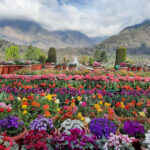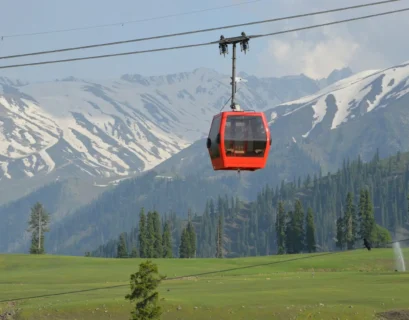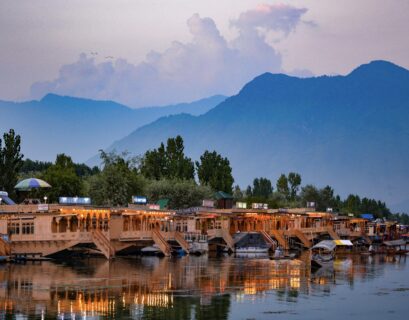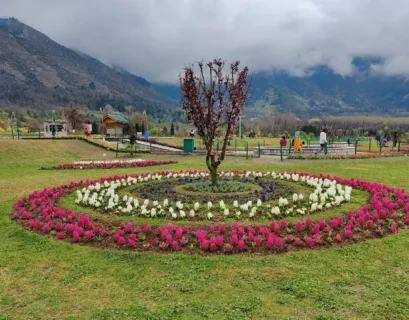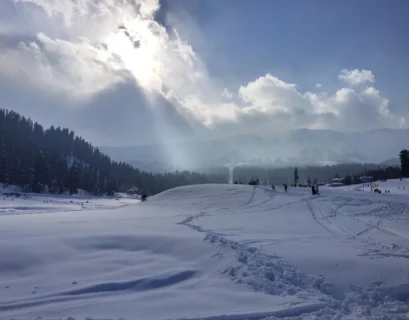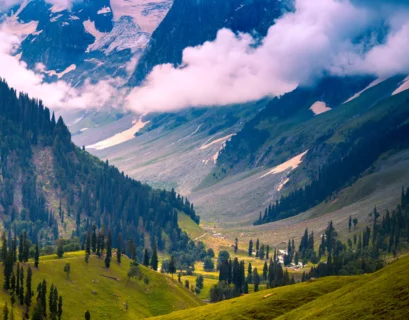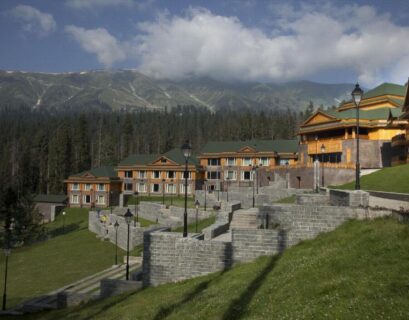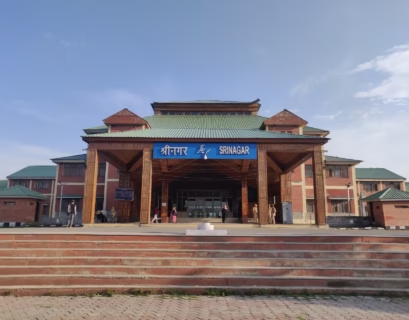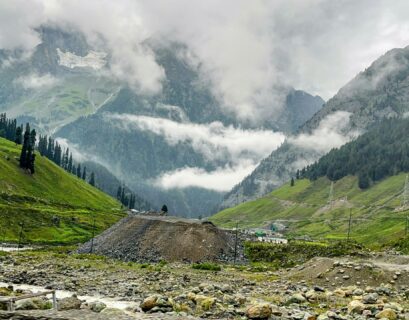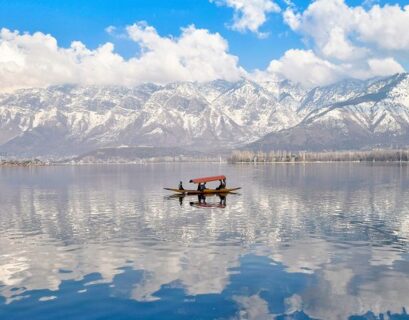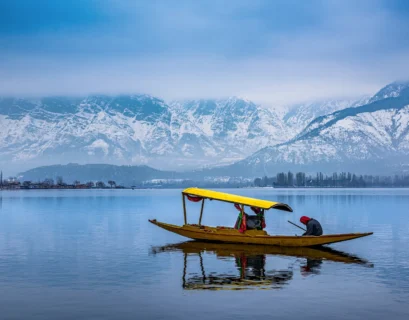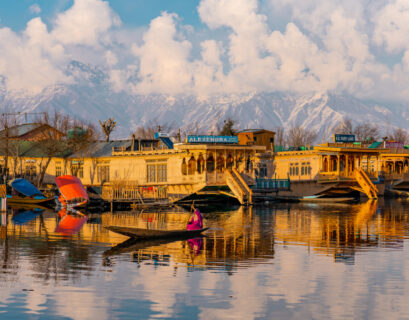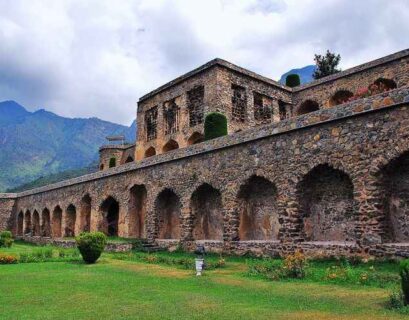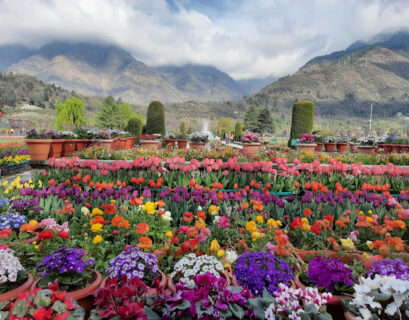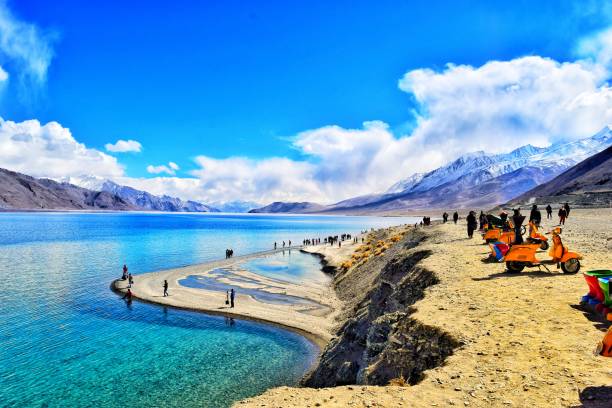Table of Contents
ToggleWeather in Kashmir Photos
Everything About Weather in Kashmir
Kashmir, often hailed as the “Paradise on Earth,” is renowned not only for its mesmerizing landscapes and rich cultural heritage but also for its diverse and dynamic weather patterns. The weather in Kashmir is a subject of immense interest for tourists, locals, and scientists alike. This blog takes you on a detailed journey through the climatic rhythms of Jammu and Kashmir, exploring everything from the biting winters to the gentle springs, the vibrant summers, and the monsoon rains that nourish the land. Read on to discover the many facets of weather in this region and understand why it plays such a crucial role in shaping life in Kashmir.
Geographical Influence on Weather in Kashmir
The Unique Geography of Kashmir
Nestled amidst the mighty Himalayas, Kashmir’s unique topography significantly influences its weather patterns. The region is characterized by sprawling valleys, high mountain peaks, and winding rivers. This diverse landscape results in microclimates that vary from one valley to another. For instance, areas nestled deep within valleys may experience cooler temperatures compared to elevated regions, where the sun’s rays are more direct.
Altitude and Its Effects
The varying altitude in Jammu and Kashmir plays a vital role in determining the weather. In higher altitudes, temperatures tend to drop sharply, especially during the winter months, leading to heavy snowfall that transforms the region into a winter wonderland. Conversely, lower areas enjoy relatively milder conditions, allowing for a variety of flora and fauna to thrive.
Proximity to Water Bodies
Kashmir’s weather is also influenced by its many lakes and rivers, such as Dal Lake in Srinagar. These water bodies moderate the climate by storing heat during the day and releasing it at night, ensuring that temperatures do not fluctuate too dramatically. This interplay between land and water creates a temperate and pleasant climate in many parts of the region.
Seasonal Variations: The Heartbeat of Kashmir
One of the most fascinating aspects of the weather in Kashmir is its pronounced seasonal changes. Each season unveils a different personality of the region, contributing to its multifaceted charm.
Winter: The Enchanting Cold
Winter in Kashmir is a season of contrasts. The chill in the air is complemented by the beauty of snow-capped mountains and frosted landscapes. In many parts of Jammu and Kashmir, the winter season is characterized by:
- Heavy Snowfall: The snowfall, especially in the higher reaches, transforms the region into a pristine, white landscape perfect for winter sports such as skiing and snowboarding.
- Crisp Air: The clear, cold air is refreshing, making winter mornings ideal for a brisk walk or a scenic drive.
- Shorter Days: While the days are shorter, the clear skies offer breathtaking starlit nights, perfect for astronomy enthusiasts.
The winter weather in Kashmir, though harsh, brings out the resilient spirit of the locals who have adapted to the cold through traditional warm clothing and unique cultural practices.
Spring: A Season of Rebirth
As winter melts away, spring arrives with a burst of colors and a gentle warmth that breathes new life into the region. During this season:
- Blooming Flora: Gardens and orchards come alive with vibrant flowers, and the famous tulip gardens in Kashmir are a sight to behold.
- Mild Temperatures: The moderate temperatures make it a perfect time for exploring the outdoors. The gradual increase in warmth encourages outdoor activities like trekking, picnics, and nature walks.
- Festivals and Celebrations: Spring is also the season of festivals, with many local celebrations that honor the rejuvenation of nature.
Summer: The Warm Embrace
Summer in Kashmir is a refreshing retreat from the scorching heat experienced in many other parts of India. The weather during these months is typically pleasant, characterized by:
- Cooler Temperatures: Despite being summer, temperatures in Kashmir rarely soar to extreme levels, providing a comfortable environment for both locals and tourists.
- Lush Greenery: The long days and abundant sunshine contribute to the region’s lush greenery, making it a paradise for nature lovers and photographers.
- Active Tourism: The mild summer weather attracts a large number of tourists, eager to escape the heat and experience the cool, invigorating air of the mountains.
Monsoon: Nature’s Gentle Shower
The monsoon season brings a different kind of charm to the weather in Kashmir. Unlike other regions where monsoons can be torrential and disruptive, the rains in Jammu and Kashmir are generally gentle and nurturing:
- Nourishing Rains: The monsoon showers help in replenishing the water sources, vital for agriculture and daily life.
- Dramatic Skies: Cloud formations and occasional thunderstorms add a dramatic flair to the scenic vistas of Kashmir.
- Enhanced Beauty: The rainfall accentuates the natural beauty of the region, with waterfalls becoming more vibrant and the landscape turning a lush green.
Weather Patterns: Analyzing Temperature, Rainfall, and Humidity
Temperature Fluctuations
The temperature in Kashmir is a subject of interest for meteorologists and climatologists alike. The region experiences significant variations:
- Diurnal Temperature Variation: The difference between daytime highs and nighttime lows is pronounced, particularly in the transitional seasons of spring and autumn.
- Seasonal Extremes: Winter brings the lowest temperatures, often plunging below freezing in many areas, while summer offers a respite with moderate temperatures that rarely exceed 30°C.
Rainfall Patterns
Rainfall in Kashmir is another crucial component of its climate:
- Distribution: Rainfall is not uniformly distributed across the region. Areas in the valleys may receive more precipitation compared to the drier, elevated regions.
- Impact on Agriculture: The well-timed monsoon rains are critical for agriculture, replenishing water supplies and ensuring bountiful harvests.
Humidity Levels
Humidity in Jammu and Kashmir varies considerably:
- Winter Dryness: Winters are generally dry, which can contribute to lower instances of mold and fungal growth but may also lead to issues like dry skin and respiratory discomfort.
- Summer Humidity: In contrast, the summer months bring higher humidity levels, making the air feel warmer despite the moderate temperatures.
The Role of Weather in Shaping Local Culture and Lifestyle
Adaptation and Tradition
The locals of Kashmir have developed a lifestyle that is intricately linked to the weather in Kashmir. From architectural designs to culinary traditions, every aspect of life is influenced by the climate:
- Traditional Clothing: The traditional attire in Kashmir, such as the pheran (a long robe), is designed to keep people warm during the harsh winters.
- Culinary Delights: Seasonal foods play a significant role in local culture. Winter recipes often include warming ingredients like spices and herbs, while summer dishes are light and refreshing.
- Festivals and Rituals: Many local festivals are timed with the changing seasons. For example, the spring festival of Navroz celebrates the onset of spring with music, dance, and traditional foods.
Impact on Daily Life
Weather in Jammu and Kashmir doesn’t just affect cultural practices; it also impacts day-to-day activities:
- Agricultural Practices: Farming is highly seasonal. Crops are planted and harvested according to the rhythm of the seasons. The weather in Kashmir thus plays a direct role in determining the agricultural calendar.
- Tourism: The seasonal allure of Kashmir makes it a year-round destination. While winter attracts snow lovers and adventure sports enthusiasts, summer and spring draw nature lovers and those looking to escape the heat.
- Transportation: Heavy snowfall in winter can disrupt transportation, necessitating robust systems to ensure connectivity even during adverse weather conditions.
Technological Advancements in Weather Forecasting
Modern Meteorological Tools
With advancements in technology, weather forecasting in Jammu and Kashmir has become more accurate and reliable. Cutting-edge tools such as Doppler radars, satellites, and automated weather stations provide real-time data:
- Real-Time Monitoring: These technologies enable meteorologists to monitor weather patterns closely and issue timely warnings about adverse conditions, such as heavy snowfall or unexpected storms.
- Data Analysis: High-resolution data analytics help in understanding long-term climatic trends, which is crucial for planning infrastructure and disaster management.
Impact on Disaster Management
Accurate weather forecasting is critical for minimizing the impact of natural disasters:
- Early Warnings: With precise weather predictions, local authorities can issue early warnings about extreme weather events, thereby reducing risks to life and property.
- Infrastructure Planning: Continuous monitoring helps in the planning and development of infrastructure that is resilient to weather extremes, ensuring that the communities in Kashmir are better prepared to face natural calamities.
Environmental Concerns and Climate Change
Changing Patterns
The global phenomenon of climate change has begun to impact even the serene landscapes of Kashmir:
- Temperature Shifts: There has been a noticeable shift in temperature patterns, with winters becoming slightly milder and summers extending longer than before.
- Erratic Weather: Unpredictable weather events, such as unseasonal snowfall or unexpected rainfall, are becoming more frequent, posing challenges for local communities and agriculture.
Local Initiatives for Sustainability
In response to these changes, several local initiatives have emerged:
- Reforestation Projects: Efforts to plant native trees and restore natural vegetation help combat soil erosion and contribute to a more stable local climate.
- Renewable Energy: The adoption of renewable energy sources, such as solar and wind, is on the rise. These initiatives not only reduce the dependency on fossil fuels but also mitigate some of the adverse effects of climate change.
- Community Awareness: Local NGOs and government bodies are increasingly focusing on educating communities about sustainable practices that can help mitigate the impact of climate change.
Tourism: The Interplay Between Weather and Visitor Experience
Seasonal Tourism Trends
Tourism in Jammu and Kashmir is deeply intertwined with its seasonal weather patterns:
- Winter Tourism: The snow-covered landscapes attract winter sports enthusiasts. Resorts and hotels cater to visitors looking to experience the magic of snowy slopes and frozen lakes.
- Summer Escapes: During summer, the cool climate offers a pleasant escape from the heat prevalent in other parts of the country. This season is ideal for sightseeing, trekking, and exploring historical sites.
- Spring Festivals: The blooming gardens and festive celebrations during spring make it a popular time for cultural tourism. The famous tulip festival is a prime example of how seasonal weather can drive tourism.
Weather-Driven Activities
The diversity of weather in Kashmir supports a range of activities that appeal to different interests:
- Adventure Sports: Activities such as skiing, snowboarding, and ice skating are prominent in winter, while trekking, river rafting, and camping are popular during the warmer months.
- Photography and Nature Walks: The ever-changing scenery provides endless opportunities for photographers and nature enthusiasts, with each season offering a unique palette of colors and moods.
- Cultural Experiences: Weather also shapes cultural experiences. Local bazaars, traditional performances, and handicraft exhibitions often have themes that align with the seasonal spirit of the region.
The Future of Weather in Jammu and Kashmir
Preparing for Change
As the world grapples with climate change, the weather in Kashmir is poised for transformation. This evolution necessitates a proactive approach to adaptation:
- Research and Development: Continuous research into local climate patterns is essential. Collaborative projects between local authorities, academic institutions, and international agencies aim to develop sustainable solutions.
- Infrastructure Upgrades: Future planning involves constructing infrastructure that can withstand extreme weather events. This includes everything from resilient roads and bridges to energy-efficient buildings designed to cope with temperature fluctuations.
- Community Resilience: Empowering local communities through education and resource allocation will be key to ensuring that they can adapt to changing weather patterns without losing their cultural heritage.
Balancing Tradition and Modernity
One of the most intriguing challenges facing Jammu and Kashmir is how to balance modern advancements with the preservation of traditional ways of life:
- Cultural Preservation: While modern technologies help predict and manage weather-related events, it is equally important to preserve traditional knowledge that has been passed down through generations. Local practices in agriculture, architecture, and medicine often incorporate centuries-old wisdom about coping with extreme weather.
- Innovative Solutions: By blending traditional methods with innovative technologies, the region can create a hybrid model that respects its past while embracing the future. This approach not only protects the local ecosystem but also maintains the unique cultural identity of Kashmir.
Practical Tips for Travelers and Locals
For the Avid Traveler
Travelers planning to explore the diverse weather in Kashmir should consider the following tips:
- Check Weather Forecasts: Before embarking on a journey, stay updated with the latest forecasts. This is particularly important in regions with unpredictable weather patterns.
- Pack Accordingly: Depending on the season, ensure you have the appropriate clothing. Warm layers are essential for winter trips, while breathable fabrics are ideal for summer adventures.
- Plan Outdoor Activities: For those interested in outdoor activities like trekking or skiing, planning in accordance with the local weather conditions can enhance your experience and ensure safety.
For the Local Resident
For residents, understanding the nuances of weather in Jammu and Kashmir can make daily life easier:
- Stay Informed: Regular updates on weather conditions can help in planning daily activities, especially during seasons prone to sudden changes.
- Community Support: Engage with local community initiatives that focus on sustainable practices and climate resilience. Such collective efforts can mitigate the impacts of extreme weather and foster a sense of unity.
- Adaptation Strategies: Invest in home improvements and energy-efficient solutions that can buffer against temperature extremes and reduce utility bills over the long term.
Conclusion
The weather in Kashmir is a mosaic of nature’s finest elements—a blend of majestic winters, blossoming springs, inviting summers, and nurturing monsoons that together create an ever-changing tapestry of life in Jammu and Kashmir. From its unique geographical position amidst the Himalayas to the cultural adaptations that have evolved over centuries, Kashmir’s climate is both a challenge and a blessing. It shapes the local lifestyle, supports agriculture, and drives tourism, while also demanding a forward-thinking approach in the face of climate change.
This intricate interplay between nature and human endeavor makes Kashmir a fascinating study in the balance of tradition and modernity. Whether you are a visitor enchanted by the beauty of its seasons or a resident deeply connected to its rhythms, understanding the weather is key to appreciating the broader story of this enchanting region.
As technology continues to enhance our ability to predict and adapt to weather patterns, the future of Jammu and Kashmir looks promising. The region’s commitment to blending time-honored practices with modern innovations will ensure that its natural beauty and cultural heritage endure, even as the climate evolves.
In the end, the magic of Kashmir lies not just in its scenic vistas but in the very air that whispers tales of resilience, hope, and an enduring connection with nature. Whether you’re marveling at the winter wonderland or strolling through vibrant spring gardens, the weather in Kashmir offers a timeless invitation to explore, learn, and be inspired.
Weather in Kashmir People Also Ask
What is the weather like in Kashmir?
The weather in Kashmir is known for its dramatic variations—from snowy, frosty winters to mild, pleasant summers—making it a region of diverse and ever-changing climates.
How does the weather in Kashmir change with the seasons?
Kashmir experiences four distinct seasons. Winters bring heavy snowfall, spring offers blooming landscapes, summer remains cool and inviting, and the monsoon season delivers gentle, nourishing rains.
When is the best time to visit Kashmir based on weather?
The ideal times to visit Kashmir are during spring and autumn when temperatures are moderate, landscapes are vibrant, and the weather is comfortable for outdoor activities.
How cold does it get in Kashmir during winter?
Winter in Kashmir can be extremely cold, with temperatures often falling below freezing. In higher altitudes, heavy snowfall creates a picturesque winter wonderland.
What is the summer weather in Kashmir like?
Summer in Kashmir is notably cooler compared to other parts of India. With temperatures rarely exceeding 30°C, the weather is ideal for sightseeing, trekking, and outdoor leisure.
How much rainfall does Kashmir receive?
Kashmir experiences moderate rainfall, mostly during the monsoon season. Rainfall patterns vary by region, significantly influencing local agriculture and water resources.
Is there snowfall in Kashmir?
Yes, snowfall is a defining feature of Kashmir’s winter. The abundant snow not only creates beautiful landscapes but also supports winter sports and related tourism activities.
What is the monsoon season like in Kashmir?
The monsoon season in Kashmir is characterized by gentle rains that refresh the landscape, fill water bodies, and enhance the region’s natural greenery without causing severe flooding.
How does altitude affect the weather in Kashmir?
Due to its varied altitudes, Kashmir experiences microclimates. Higher elevations see colder temperatures and more snowfall, whereas lower regions enjoy milder, more stable conditions.
Are there weather warnings for extreme conditions in Kashmir?
Yes, local meteorological departments issue warnings for extreme weather conditions such as heavy snowfall, severe cold snaps, and unseasonal rains, ensuring safety for residents and visitors.
What role do lakes and rivers play in Kashmir’s weather?
Lakes and rivers, like the iconic Dal Lake, help moderate the local climate by absorbing heat during the day and releasing it at night, leading to more balanced temperatures.
How is climate change affecting the weather in Kashmir?
Climate change is causing noticeable shifts in Kashmir’s weather patterns, including milder winters, unpredictable snowfall, and altered monsoon patterns, which are closely monitored by experts.
What are the temperature variations in Kashmir throughout the day?
Kashmir experiences significant diurnal temperature variations, with warm, sunny days and much cooler nights—especially pronounced during transitional seasons.
What is the humidity level like in Kashmir?
Humidity in Kashmir varies seasonally. Winters tend to be dry, while summers and the monsoon period see increased humidity, affecting both comfort and local ecosystems.
Does weather in Kashmir impact agriculture?
Absolutely. The seasonal variations—rainfall during the monsoon and the crisp winter air—play a crucial role in determining the agricultural calendar, affecting crop growth and yield.
Are there weather forecasting services available for Kashmir?
Yes, advanced meteorological tools and local forecasting services provide regular updates on the weather in Kashmir, helping residents and tourists prepare for any sudden changes.
How do local residents adapt to extreme weather in Kashmir?
Residents have adapted by using traditional clothing like the pheran for warmth, constructing insulated homes, and employing community-based strategies to cope with heavy snowfall and cold conditions.
What traditional clothing is worn due to Kashmir’s weather?
In response to the cold climate, locals often wear the pheran—a long, comfortable robe designed to provide warmth during the harsh winter months while reflecting cultural heritage.
How does the weather in Kashmir affect tourism?
The varied weather in Kashmir is a major draw for tourists. Winter attracts snow sports enthusiasts, while the mild summers and vibrant spring landscapes appeal to those looking for scenic beauty and outdoor activities.
What outdoor activities are popular in Kashmir during winter?
Winter in Kashmir is ideal for activities like skiing, snowboarding, ice skating, and snow trekking, which attract adventure seekers and winter sports enthusiasts from around the world.
How does the weather in Kashmir influence local festivals?
Many local festivals in Kashmir are scheduled to coincide with favorable weather conditions. Spring festivals celebrate the bloom of nature, while winter events often highlight traditional celebrations against a snowy backdrop.
What is the average temperature in Kashmir during spring?
During spring, temperatures in Kashmir generally range from 10°C to 20°C, offering a refreshing climate that encourages outdoor activities and the enjoyment of blooming flora.
How do transportation systems in Kashmir cope with winter weather?
Transportation in Kashmir is adapted to handle heavy snowfall through timely maintenance, specialized vehicles, and efficient communication systems that alert travelers to road conditions and closures.
Can I experience clear skies and starry nights in Kashmir?
Yes, due to its high altitude and relatively low light pollution, Kashmir often features clear skies and spectacular starry nights, especially during the crisp winter months.
What is the forecast for the weather in Jammu and Kashmir?
Weather forecasts for Jammu and Kashmir are regularly updated with real-time data, providing detailed information on temperature changes, precipitation, and any weather alerts to help residents and tourists plan their activities.



